Analyzing Subsidies in International Aviation Disputes
VerifiedAdded on 2020/05/04
|10
|1685
|29
AI Summary
This comprehensive assignment examines the role of international subsidies within the aviation and aluminum industries. It highlights significant trade disputes involving key players such as Boeing, Airbus, and China's aluminum producers. The analysis covers how the US and European governments have provided subsidies to their respective aviation giants, with specific focus on allegations against Washington State’s tax breaks for Boeing and Europe's countermeasures to support Airbus. The study also explores a major WTO dispute over alleged illegal subsidies in China's aluminum sector. Through these cases, it discusses the strategic implications of subsidies, potential violations of World Trade Organization norms, and the broader impacts on global market competition.
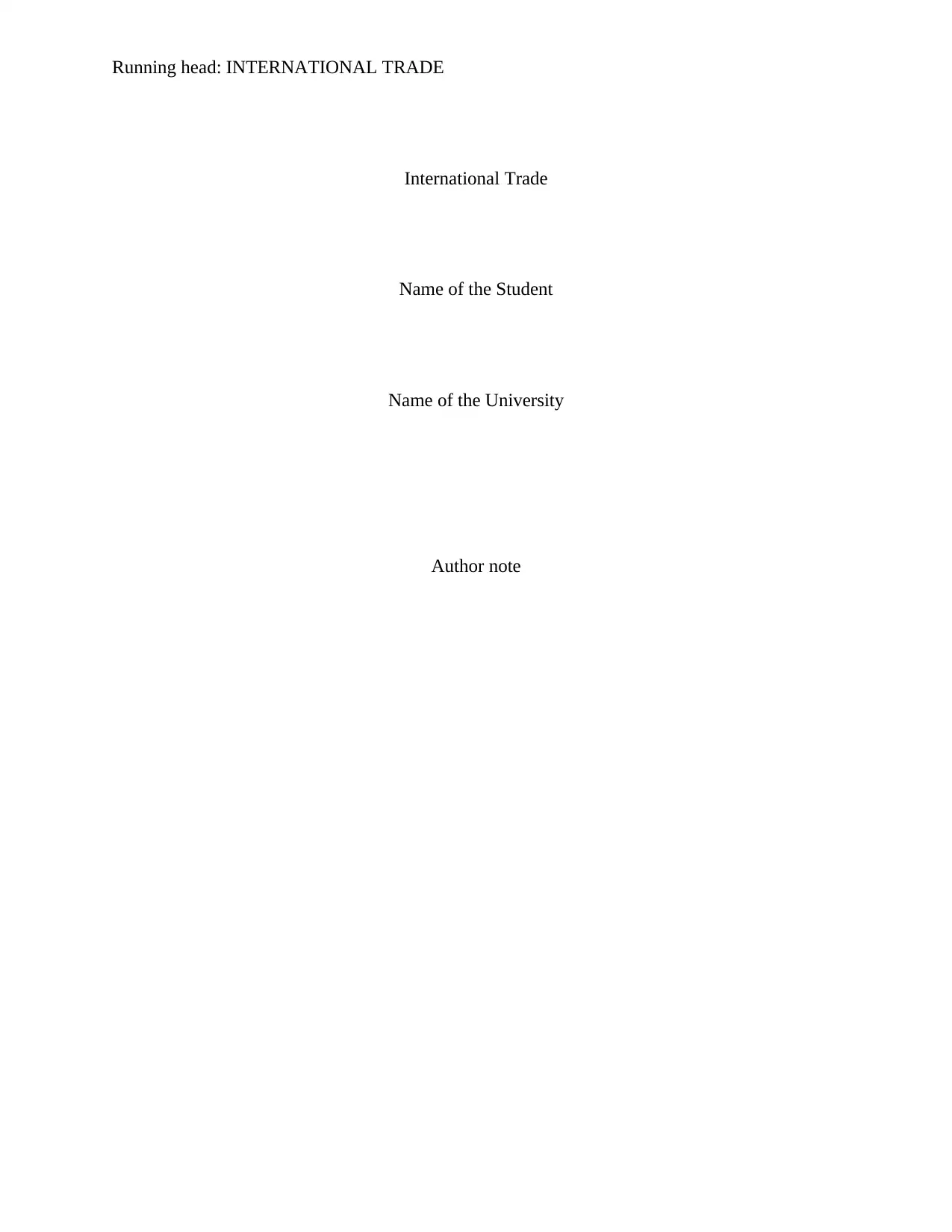
Running head: INTERNATIONAL TRADE
International Trade
Name of the Student
Name of the University
Author note
International Trade
Name of the Student
Name of the University
Author note
Paraphrase This Document
Need a fresh take? Get an instant paraphrase of this document with our AI Paraphraser
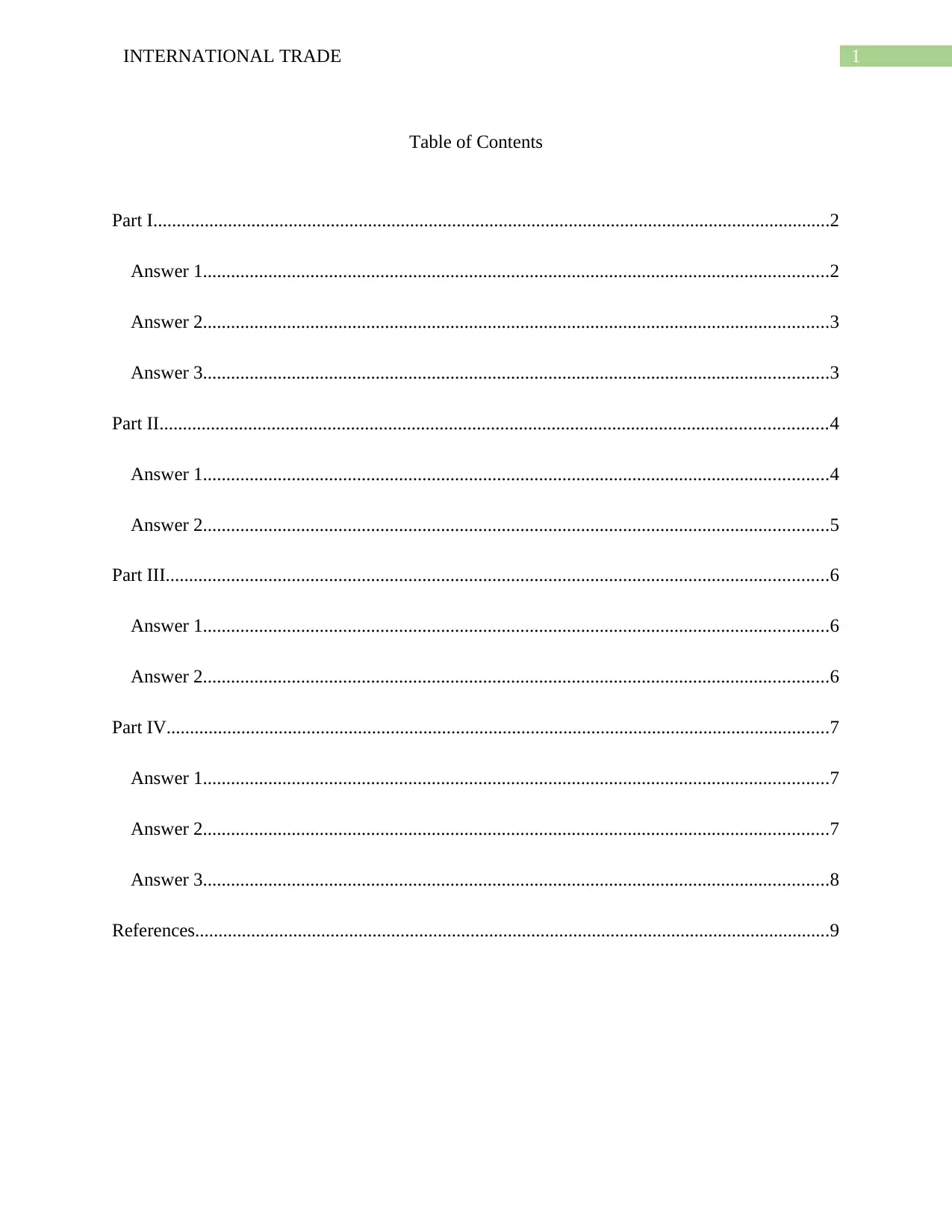
1INTERNATIONAL TRADE
Table of Contents
Part I.................................................................................................................................................2
Answer 1......................................................................................................................................2
Answer 2......................................................................................................................................3
Answer 3......................................................................................................................................3
Part II...............................................................................................................................................4
Answer 1......................................................................................................................................4
Answer 2......................................................................................................................................5
Part III..............................................................................................................................................6
Answer 1......................................................................................................................................6
Answer 2......................................................................................................................................6
Part IV..............................................................................................................................................7
Answer 1......................................................................................................................................7
Answer 2......................................................................................................................................7
Answer 3......................................................................................................................................8
References........................................................................................................................................9
Table of Contents
Part I.................................................................................................................................................2
Answer 1......................................................................................................................................2
Answer 2......................................................................................................................................3
Answer 3......................................................................................................................................3
Part II...............................................................................................................................................4
Answer 1......................................................................................................................................4
Answer 2......................................................................................................................................5
Part III..............................................................................................................................................6
Answer 1......................................................................................................................................6
Answer 2......................................................................................................................................6
Part IV..............................................................................................................................................7
Answer 1......................................................................................................................................7
Answer 2......................................................................................................................................7
Answer 3......................................................................................................................................8
References........................................................................................................................................9
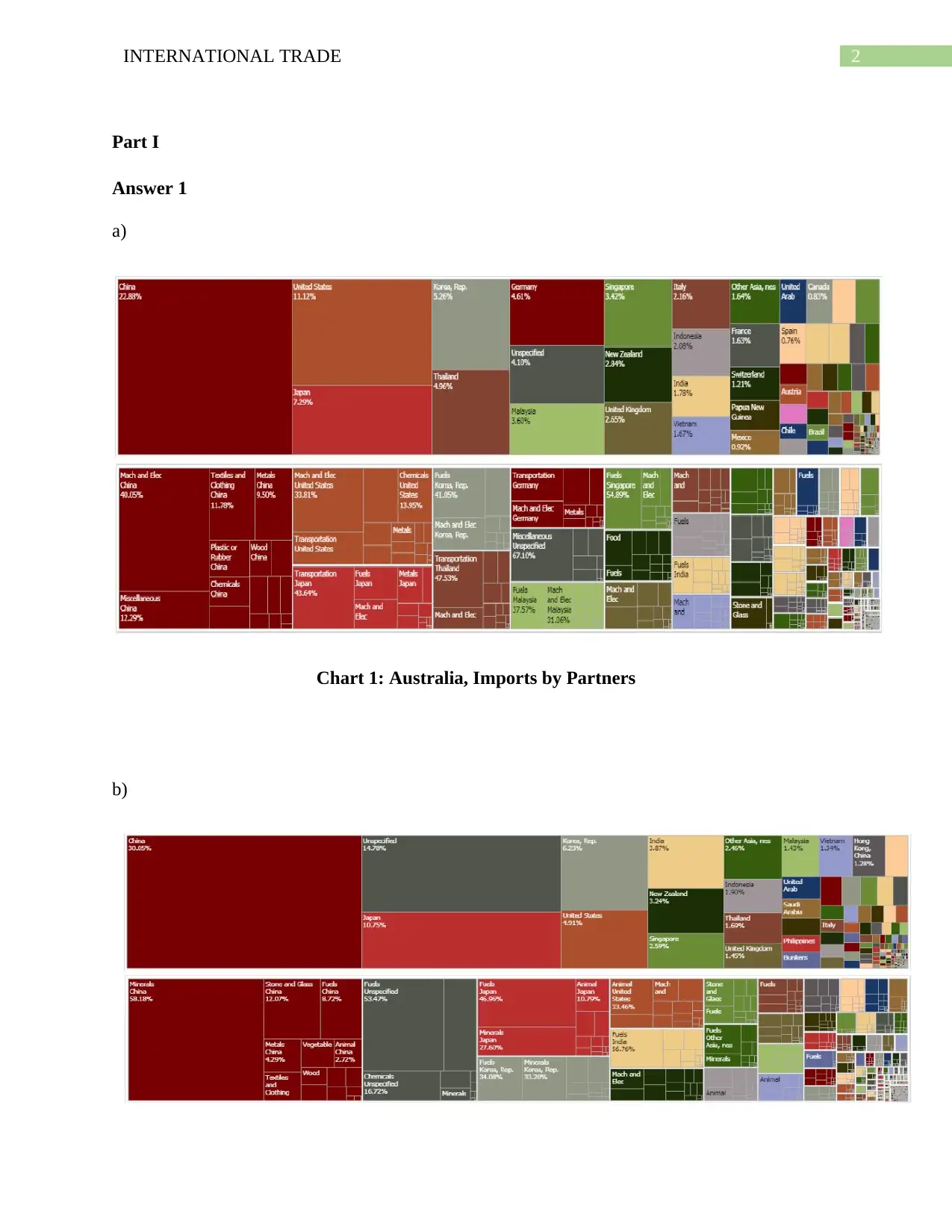
2INTERNATIONAL TRADE
Part I
Answer 1
a)
Chart 1: Australia, Imports by Partners
b)
Part I
Answer 1
a)
Chart 1: Australia, Imports by Partners
b)
⊘ This is a preview!⊘
Do you want full access?
Subscribe today to unlock all pages.

Trusted by 1+ million students worldwide
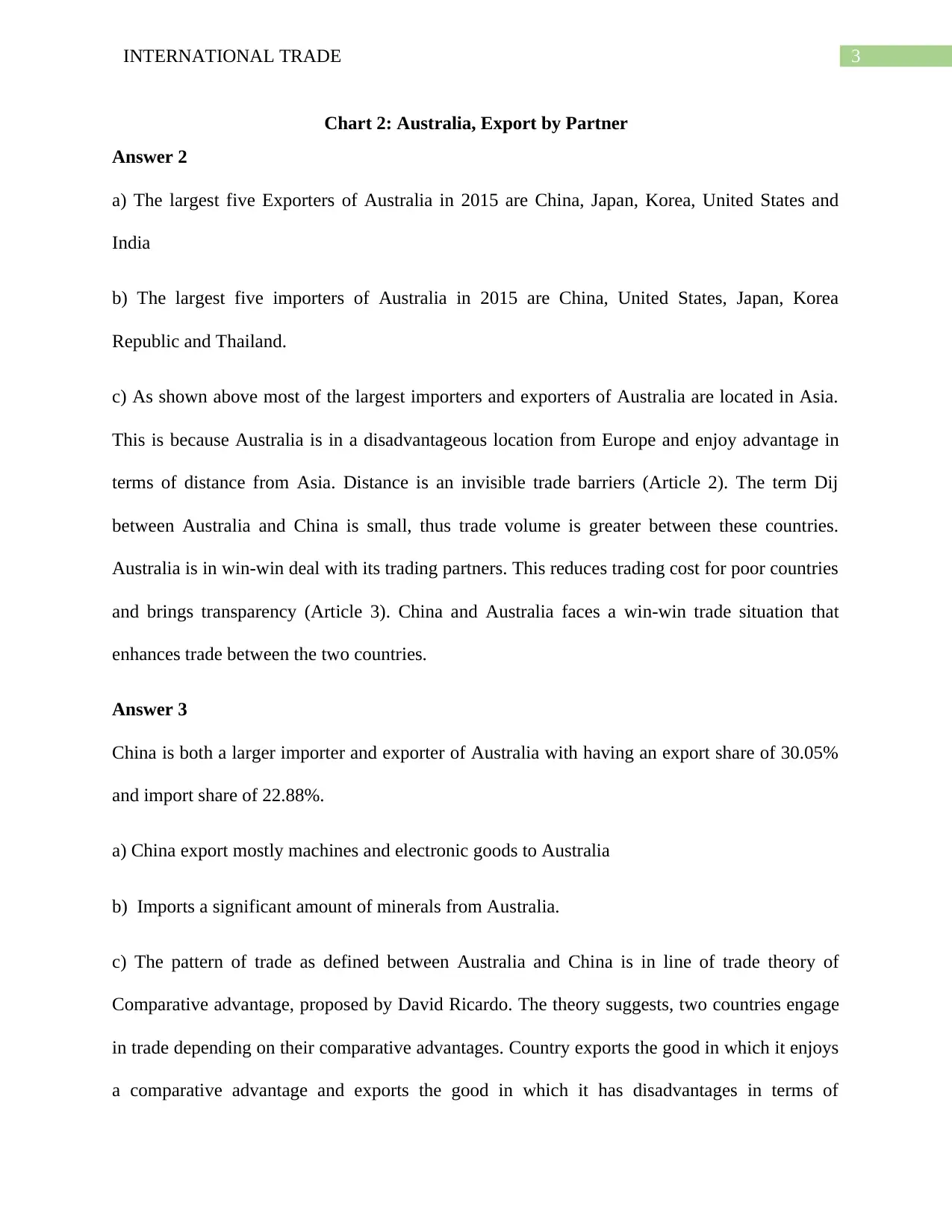
3INTERNATIONAL TRADE
Chart 2: Australia, Export by Partner
Answer 2
a) The largest five Exporters of Australia in 2015 are China, Japan, Korea, United States and
India
b) The largest five importers of Australia in 2015 are China, United States, Japan, Korea
Republic and Thailand.
c) As shown above most of the largest importers and exporters of Australia are located in Asia.
This is because Australia is in a disadvantageous location from Europe and enjoy advantage in
terms of distance from Asia. Distance is an invisible trade barriers (Article 2). The term Dij
between Australia and China is small, thus trade volume is greater between these countries.
Australia is in win-win deal with its trading partners. This reduces trading cost for poor countries
and brings transparency (Article 3). China and Australia faces a win-win trade situation that
enhances trade between the two countries.
Answer 3
China is both a larger importer and exporter of Australia with having an export share of 30.05%
and import share of 22.88%.
a) China export mostly machines and electronic goods to Australia
b) Imports a significant amount of minerals from Australia.
c) The pattern of trade as defined between Australia and China is in line of trade theory of
Comparative advantage, proposed by David Ricardo. The theory suggests, two countries engage
in trade depending on their comparative advantages. Country exports the good in which it enjoys
a comparative advantage and exports the good in which it has disadvantages in terms of
Chart 2: Australia, Export by Partner
Answer 2
a) The largest five Exporters of Australia in 2015 are China, Japan, Korea, United States and
India
b) The largest five importers of Australia in 2015 are China, United States, Japan, Korea
Republic and Thailand.
c) As shown above most of the largest importers and exporters of Australia are located in Asia.
This is because Australia is in a disadvantageous location from Europe and enjoy advantage in
terms of distance from Asia. Distance is an invisible trade barriers (Article 2). The term Dij
between Australia and China is small, thus trade volume is greater between these countries.
Australia is in win-win deal with its trading partners. This reduces trading cost for poor countries
and brings transparency (Article 3). China and Australia faces a win-win trade situation that
enhances trade between the two countries.
Answer 3
China is both a larger importer and exporter of Australia with having an export share of 30.05%
and import share of 22.88%.
a) China export mostly machines and electronic goods to Australia
b) Imports a significant amount of minerals from Australia.
c) The pattern of trade as defined between Australia and China is in line of trade theory of
Comparative advantage, proposed by David Ricardo. The theory suggests, two countries engage
in trade depending on their comparative advantages. Country exports the good in which it enjoys
a comparative advantage and exports the good in which it has disadvantages in terms of
Paraphrase This Document
Need a fresh take? Get an instant paraphrase of this document with our AI Paraphraser
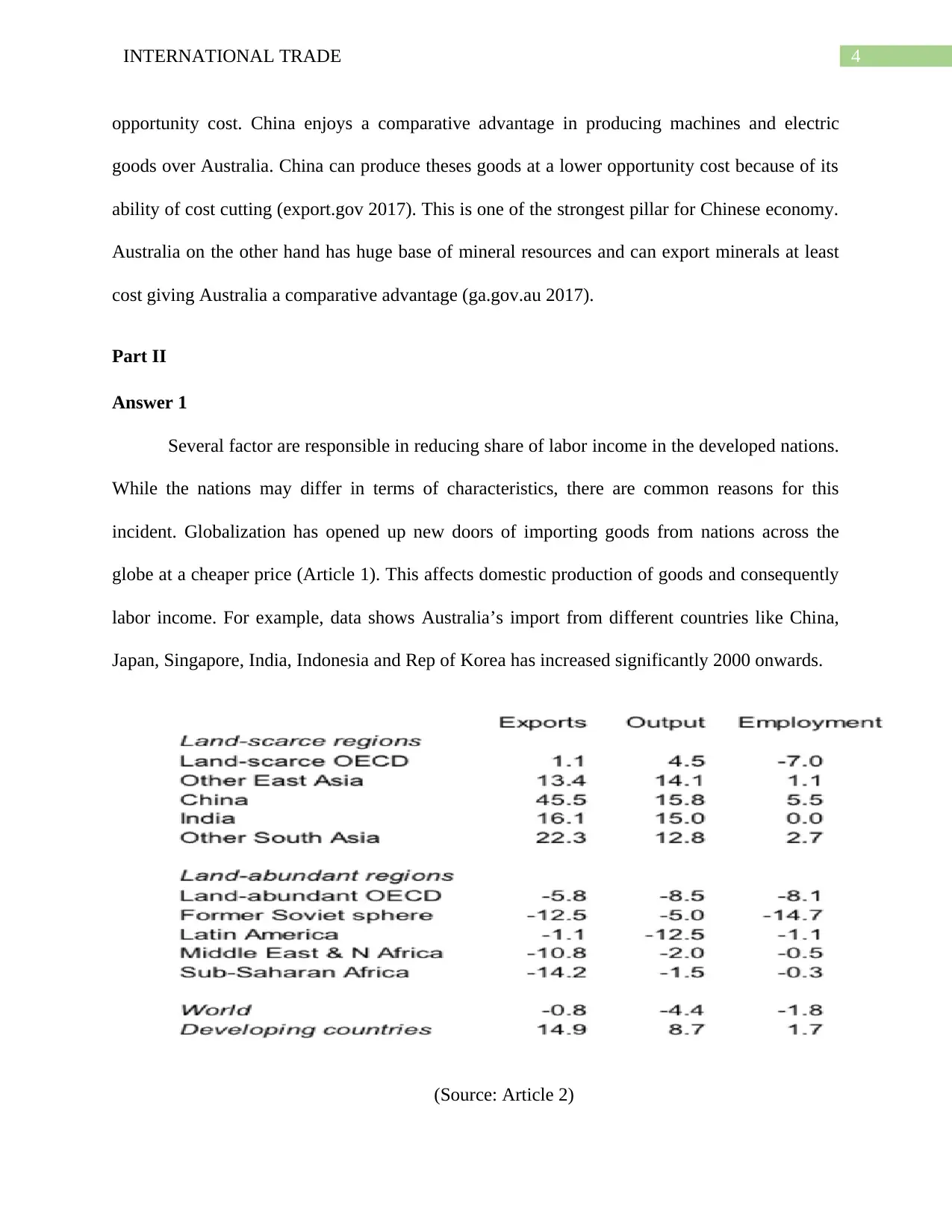
4INTERNATIONAL TRADE
opportunity cost. China enjoys a comparative advantage in producing machines and electric
goods over Australia. China can produce theses goods at a lower opportunity cost because of its
ability of cost cutting (export.gov 2017). This is one of the strongest pillar for Chinese economy.
Australia on the other hand has huge base of mineral resources and can export minerals at least
cost giving Australia a comparative advantage (ga.gov.au 2017).
Part II
Answer 1
Several factor are responsible in reducing share of labor income in the developed nations.
While the nations may differ in terms of characteristics, there are common reasons for this
incident. Globalization has opened up new doors of importing goods from nations across the
globe at a cheaper price (Article 1). This affects domestic production of goods and consequently
labor income. For example, data shows Australia’s import from different countries like China,
Japan, Singapore, India, Indonesia and Rep of Korea has increased significantly 2000 onwards.
(Source: Article 2)
opportunity cost. China enjoys a comparative advantage in producing machines and electric
goods over Australia. China can produce theses goods at a lower opportunity cost because of its
ability of cost cutting (export.gov 2017). This is one of the strongest pillar for Chinese economy.
Australia on the other hand has huge base of mineral resources and can export minerals at least
cost giving Australia a comparative advantage (ga.gov.au 2017).
Part II
Answer 1
Several factor are responsible in reducing share of labor income in the developed nations.
While the nations may differ in terms of characteristics, there are common reasons for this
incident. Globalization has opened up new doors of importing goods from nations across the
globe at a cheaper price (Article 1). This affects domestic production of goods and consequently
labor income. For example, data shows Australia’s import from different countries like China,
Japan, Singapore, India, Indonesia and Rep of Korea has increased significantly 2000 onwards.
(Source: Article 2)
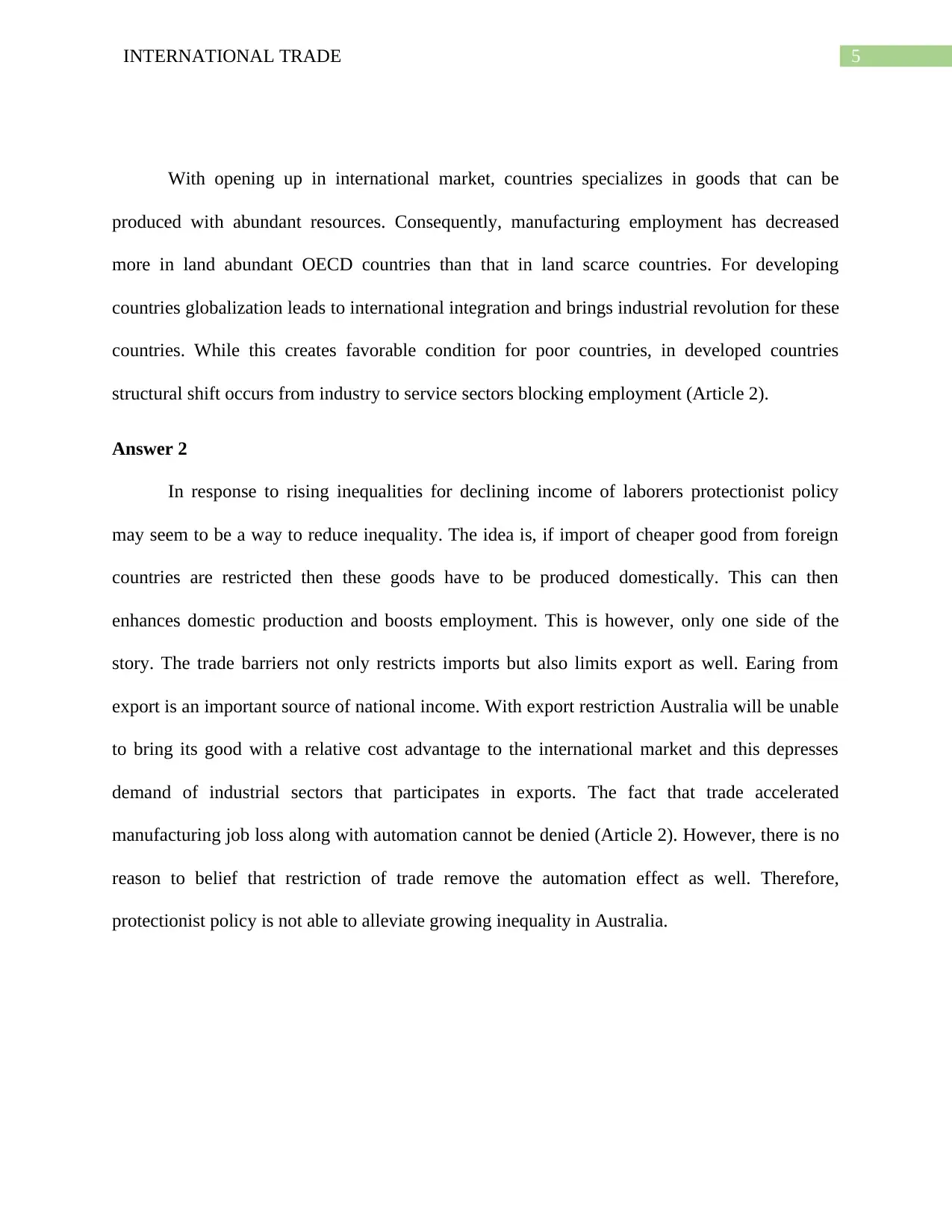
5INTERNATIONAL TRADE
With opening up in international market, countries specializes in goods that can be
produced with abundant resources. Consequently, manufacturing employment has decreased
more in land abundant OECD countries than that in land scarce countries. For developing
countries globalization leads to international integration and brings industrial revolution for these
countries. While this creates favorable condition for poor countries, in developed countries
structural shift occurs from industry to service sectors blocking employment (Article 2).
Answer 2
In response to rising inequalities for declining income of laborers protectionist policy
may seem to be a way to reduce inequality. The idea is, if import of cheaper good from foreign
countries are restricted then these goods have to be produced domestically. This can then
enhances domestic production and boosts employment. This is however, only one side of the
story. The trade barriers not only restricts imports but also limits export as well. Earing from
export is an important source of national income. With export restriction Australia will be unable
to bring its good with a relative cost advantage to the international market and this depresses
demand of industrial sectors that participates in exports. The fact that trade accelerated
manufacturing job loss along with automation cannot be denied (Article 2). However, there is no
reason to belief that restriction of trade remove the automation effect as well. Therefore,
protectionist policy is not able to alleviate growing inequality in Australia.
With opening up in international market, countries specializes in goods that can be
produced with abundant resources. Consequently, manufacturing employment has decreased
more in land abundant OECD countries than that in land scarce countries. For developing
countries globalization leads to international integration and brings industrial revolution for these
countries. While this creates favorable condition for poor countries, in developed countries
structural shift occurs from industry to service sectors blocking employment (Article 2).
Answer 2
In response to rising inequalities for declining income of laborers protectionist policy
may seem to be a way to reduce inequality. The idea is, if import of cheaper good from foreign
countries are restricted then these goods have to be produced domestically. This can then
enhances domestic production and boosts employment. This is however, only one side of the
story. The trade barriers not only restricts imports but also limits export as well. Earing from
export is an important source of national income. With export restriction Australia will be unable
to bring its good with a relative cost advantage to the international market and this depresses
demand of industrial sectors that participates in exports. The fact that trade accelerated
manufacturing job loss along with automation cannot be denied (Article 2). However, there is no
reason to belief that restriction of trade remove the automation effect as well. Therefore,
protectionist policy is not able to alleviate growing inequality in Australia.
⊘ This is a preview!⊘
Do you want full access?
Subscribe today to unlock all pages.

Trusted by 1+ million students worldwide
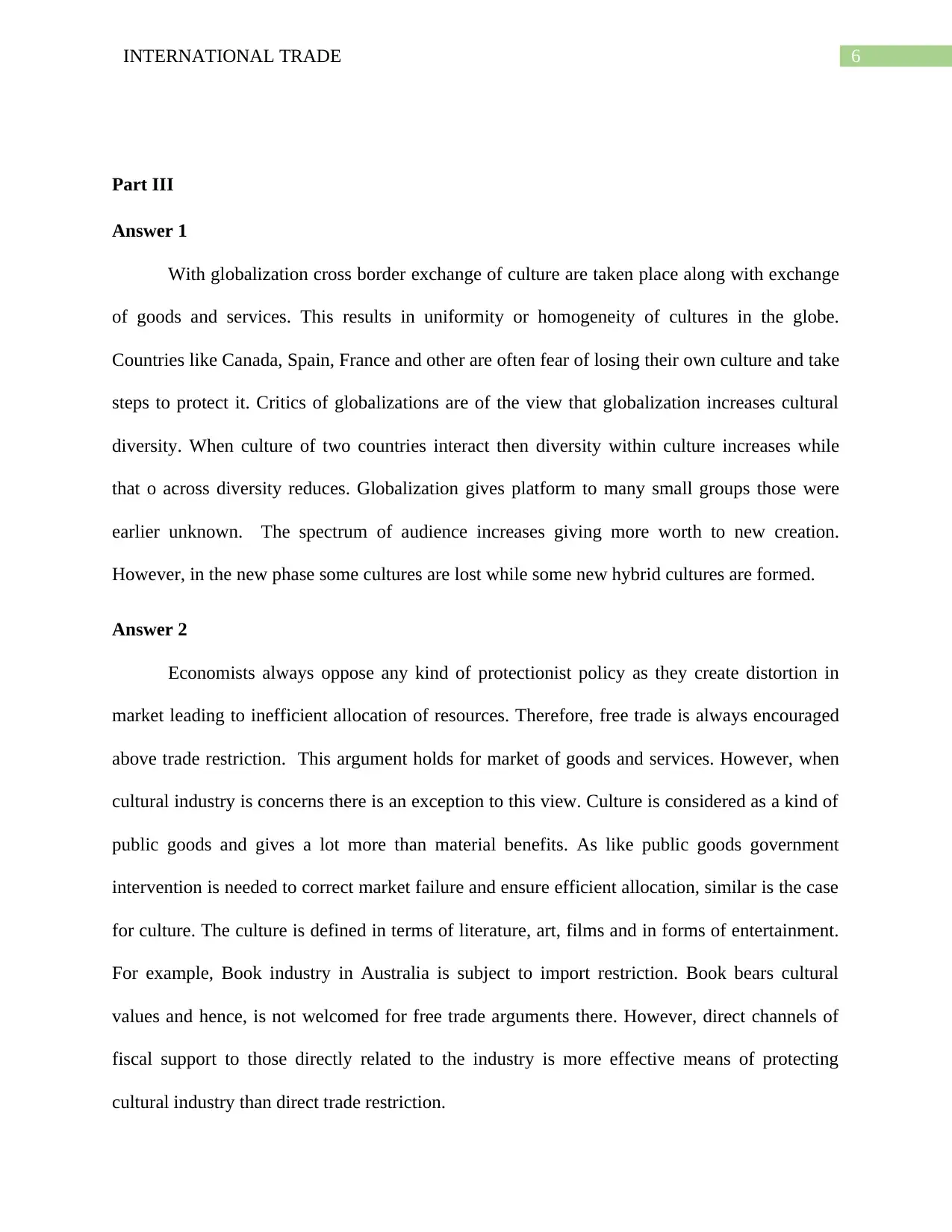
6INTERNATIONAL TRADE
Part III
Answer 1
With globalization cross border exchange of culture are taken place along with exchange
of goods and services. This results in uniformity or homogeneity of cultures in the globe.
Countries like Canada, Spain, France and other are often fear of losing their own culture and take
steps to protect it. Critics of globalizations are of the view that globalization increases cultural
diversity. When culture of two countries interact then diversity within culture increases while
that o across diversity reduces. Globalization gives platform to many small groups those were
earlier unknown. The spectrum of audience increases giving more worth to new creation.
However, in the new phase some cultures are lost while some new hybrid cultures are formed.
Answer 2
Economists always oppose any kind of protectionist policy as they create distortion in
market leading to inefficient allocation of resources. Therefore, free trade is always encouraged
above trade restriction. This argument holds for market of goods and services. However, when
cultural industry is concerns there is an exception to this view. Culture is considered as a kind of
public goods and gives a lot more than material benefits. As like public goods government
intervention is needed to correct market failure and ensure efficient allocation, similar is the case
for culture. The culture is defined in terms of literature, art, films and in forms of entertainment.
For example, Book industry in Australia is subject to import restriction. Book bears cultural
values and hence, is not welcomed for free trade arguments there. However, direct channels of
fiscal support to those directly related to the industry is more effective means of protecting
cultural industry than direct trade restriction.
Part III
Answer 1
With globalization cross border exchange of culture are taken place along with exchange
of goods and services. This results in uniformity or homogeneity of cultures in the globe.
Countries like Canada, Spain, France and other are often fear of losing their own culture and take
steps to protect it. Critics of globalizations are of the view that globalization increases cultural
diversity. When culture of two countries interact then diversity within culture increases while
that o across diversity reduces. Globalization gives platform to many small groups those were
earlier unknown. The spectrum of audience increases giving more worth to new creation.
However, in the new phase some cultures are lost while some new hybrid cultures are formed.
Answer 2
Economists always oppose any kind of protectionist policy as they create distortion in
market leading to inefficient allocation of resources. Therefore, free trade is always encouraged
above trade restriction. This argument holds for market of goods and services. However, when
cultural industry is concerns there is an exception to this view. Culture is considered as a kind of
public goods and gives a lot more than material benefits. As like public goods government
intervention is needed to correct market failure and ensure efficient allocation, similar is the case
for culture. The culture is defined in terms of literature, art, films and in forms of entertainment.
For example, Book industry in Australia is subject to import restriction. Book bears cultural
values and hence, is not welcomed for free trade arguments there. However, direct channels of
fiscal support to those directly related to the industry is more effective means of protecting
cultural industry than direct trade restriction.
Paraphrase This Document
Need a fresh take? Get an instant paraphrase of this document with our AI Paraphraser
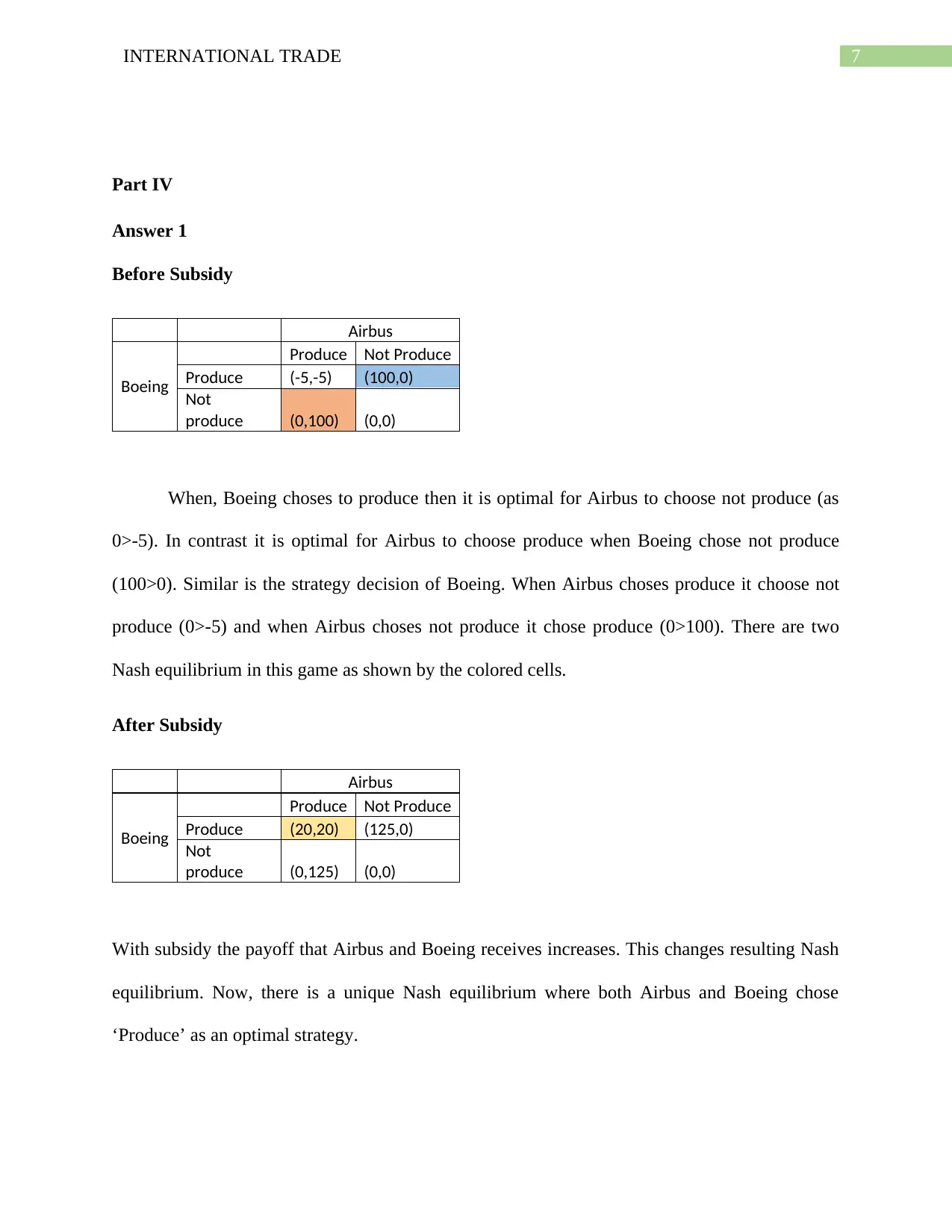
7INTERNATIONAL TRADE
Part IV
Answer 1
Before Subsidy
Airbus
Boeing
Produce Not Produce
Produce (-5,-5) (100,0)
Not
produce (0,100) (0,0)
When, Boeing choses to produce then it is optimal for Airbus to choose not produce (as
0>-5). In contrast it is optimal for Airbus to choose produce when Boeing chose not produce
(100>0). Similar is the strategy decision of Boeing. When Airbus choses produce it choose not
produce (0>-5) and when Airbus choses not produce it chose produce (0>100). There are two
Nash equilibrium in this game as shown by the colored cells.
After Subsidy
Airbus
Boeing
Produce Not Produce
Produce (20,20) (125,0)
Not
produce (0,125) (0,0)
With subsidy the payoff that Airbus and Boeing receives increases. This changes resulting Nash
equilibrium. Now, there is a unique Nash equilibrium where both Airbus and Boeing chose
‘Produce’ as an optimal strategy.
Part IV
Answer 1
Before Subsidy
Airbus
Boeing
Produce Not Produce
Produce (-5,-5) (100,0)
Not
produce (0,100) (0,0)
When, Boeing choses to produce then it is optimal for Airbus to choose not produce (as
0>-5). In contrast it is optimal for Airbus to choose produce when Boeing chose not produce
(100>0). Similar is the strategy decision of Boeing. When Airbus choses produce it choose not
produce (0>-5) and when Airbus choses not produce it chose produce (0>100). There are two
Nash equilibrium in this game as shown by the colored cells.
After Subsidy
Airbus
Boeing
Produce Not Produce
Produce (20,20) (125,0)
Not
produce (0,125) (0,0)
With subsidy the payoff that Airbus and Boeing receives increases. This changes resulting Nash
equilibrium. Now, there is a unique Nash equilibrium where both Airbus and Boeing chose
‘Produce’ as an optimal strategy.
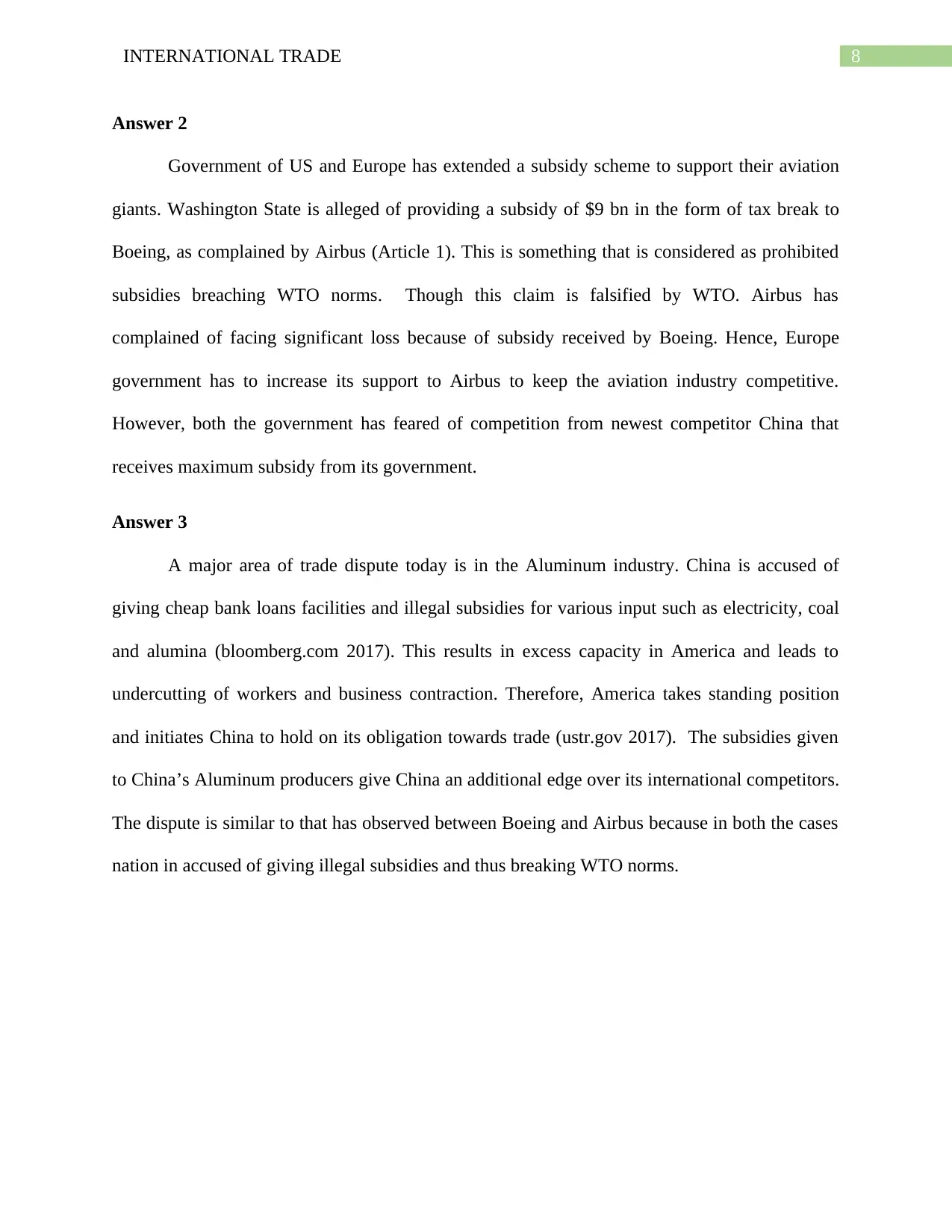
8INTERNATIONAL TRADE
Answer 2
Government of US and Europe has extended a subsidy scheme to support their aviation
giants. Washington State is alleged of providing a subsidy of $9 bn in the form of tax break to
Boeing, as complained by Airbus (Article 1). This is something that is considered as prohibited
subsidies breaching WTO norms. Though this claim is falsified by WTO. Airbus has
complained of facing significant loss because of subsidy received by Boeing. Hence, Europe
government has to increase its support to Airbus to keep the aviation industry competitive.
However, both the government has feared of competition from newest competitor China that
receives maximum subsidy from its government.
Answer 3
A major area of trade dispute today is in the Aluminum industry. China is accused of
giving cheap bank loans facilities and illegal subsidies for various input such as electricity, coal
and alumina (bloomberg.com 2017). This results in excess capacity in America and leads to
undercutting of workers and business contraction. Therefore, America takes standing position
and initiates China to hold on its obligation towards trade (ustr.gov 2017). The subsidies given
to China’s Aluminum producers give China an additional edge over its international competitors.
The dispute is similar to that has observed between Boeing and Airbus because in both the cases
nation in accused of giving illegal subsidies and thus breaking WTO norms.
Answer 2
Government of US and Europe has extended a subsidy scheme to support their aviation
giants. Washington State is alleged of providing a subsidy of $9 bn in the form of tax break to
Boeing, as complained by Airbus (Article 1). This is something that is considered as prohibited
subsidies breaching WTO norms. Though this claim is falsified by WTO. Airbus has
complained of facing significant loss because of subsidy received by Boeing. Hence, Europe
government has to increase its support to Airbus to keep the aviation industry competitive.
However, both the government has feared of competition from newest competitor China that
receives maximum subsidy from its government.
Answer 3
A major area of trade dispute today is in the Aluminum industry. China is accused of
giving cheap bank loans facilities and illegal subsidies for various input such as electricity, coal
and alumina (bloomberg.com 2017). This results in excess capacity in America and leads to
undercutting of workers and business contraction. Therefore, America takes standing position
and initiates China to hold on its obligation towards trade (ustr.gov 2017). The subsidies given
to China’s Aluminum producers give China an additional edge over its international competitors.
The dispute is similar to that has observed between Boeing and Airbus because in both the cases
nation in accused of giving illegal subsidies and thus breaking WTO norms.
⊘ This is a preview!⊘
Do you want full access?
Subscribe today to unlock all pages.

Trusted by 1+ million students worldwide
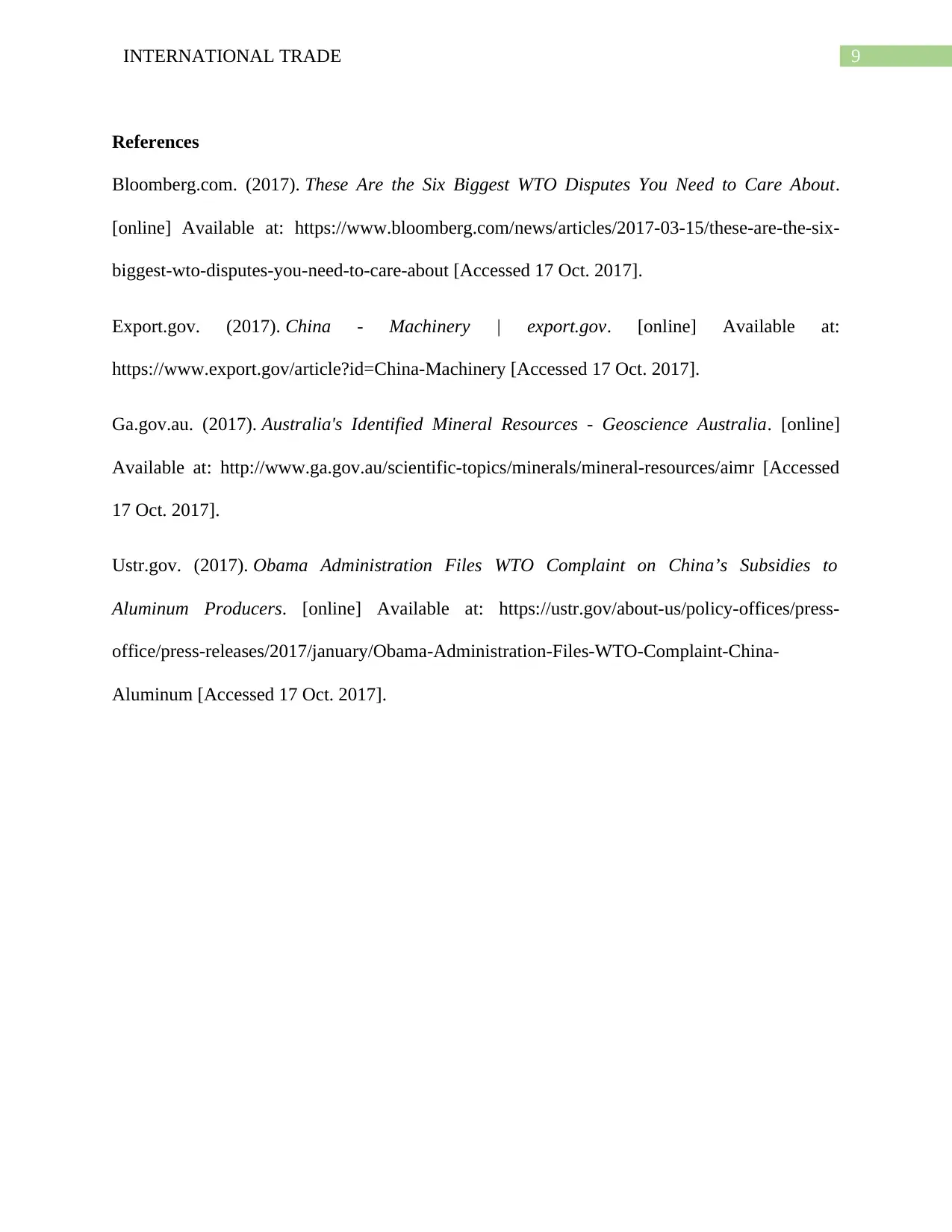
9INTERNATIONAL TRADE
References
Bloomberg.com. (2017). These Are the Six Biggest WTO Disputes You Need to Care About.
[online] Available at: https://www.bloomberg.com/news/articles/2017-03-15/these-are-the-six-
biggest-wto-disputes-you-need-to-care-about [Accessed 17 Oct. 2017].
Export.gov. (2017). China - Machinery | export.gov. [online] Available at:
https://www.export.gov/article?id=China-Machinery [Accessed 17 Oct. 2017].
Ga.gov.au. (2017). Australia's Identified Mineral Resources - Geoscience Australia. [online]
Available at: http://www.ga.gov.au/scientific-topics/minerals/mineral-resources/aimr [Accessed
17 Oct. 2017].
Ustr.gov. (2017). Obama Administration Files WTO Complaint on China’s Subsidies to
Aluminum Producers. [online] Available at: https://ustr.gov/about-us/policy-offices/press-
office/press-releases/2017/january/Obama-Administration-Files-WTO-Complaint-China-
Aluminum [Accessed 17 Oct. 2017].
References
Bloomberg.com. (2017). These Are the Six Biggest WTO Disputes You Need to Care About.
[online] Available at: https://www.bloomberg.com/news/articles/2017-03-15/these-are-the-six-
biggest-wto-disputes-you-need-to-care-about [Accessed 17 Oct. 2017].
Export.gov. (2017). China - Machinery | export.gov. [online] Available at:
https://www.export.gov/article?id=China-Machinery [Accessed 17 Oct. 2017].
Ga.gov.au. (2017). Australia's Identified Mineral Resources - Geoscience Australia. [online]
Available at: http://www.ga.gov.au/scientific-topics/minerals/mineral-resources/aimr [Accessed
17 Oct. 2017].
Ustr.gov. (2017). Obama Administration Files WTO Complaint on China’s Subsidies to
Aluminum Producers. [online] Available at: https://ustr.gov/about-us/policy-offices/press-
office/press-releases/2017/january/Obama-Administration-Files-WTO-Complaint-China-
Aluminum [Accessed 17 Oct. 2017].
1 out of 10
Related Documents
Your All-in-One AI-Powered Toolkit for Academic Success.
+13062052269
info@desklib.com
Available 24*7 on WhatsApp / Email
![[object Object]](/_next/static/media/star-bottom.7253800d.svg)
Unlock your academic potential
Copyright © 2020–2025 A2Z Services. All Rights Reserved. Developed and managed by ZUCOL.





